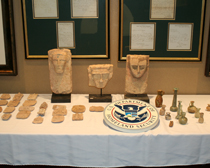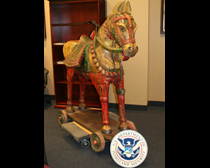Archived Content
In an effort to keep ICE.gov current, the archive contains content from a previous administration or is otherwise outdated. This information is archived and not reflective of current practice.
ICE makes arrests and seizes cultural artifacts stolen from Egypt
NEW YORK — Antiquity dealers and collectors from Michigan, New York, Virginia and the United Arab Emirates (UAE) were charged today in connection with a scheme to smuggle illicit cultural property into the United States. U.S. Immigration and Customs Enforcement's (ICE) Homeland Security Investigations (HSI) agents dismantled an organization responsible for conspiring to smuggle Egyptian Middle Eastern and Asian antiquities into the United States and conspiring to launder money in furtherance of smuggling.
ICE HSI agents who specialize in cultural property investigations seized Egyptian antiquities to include but are not limited to a Greco-Roman style Egyptian sarcophagus, a unique three-part coffin set belonging to Shesepamuntayesher from the Saite period or 26th Dynasty, approximately 664-552 B.C. In addition to Egyptian antiquities, other Middle Eastern and Asian artifacts along with more than a thousand antique coins have been recovered.
ICE HSI agents arrested: Salem Alshdaifat, an antiquities dealer who operated a business called Holyland Numismatics in Bloomfield, Mich.; Joseph Lewis, a collector and benefactor of Egyptian antiquities; and Mousa Kouli, an antiquities dealer who operated a business called Windsor Antiquities in New York.
Ayman Ramadan, a Jordanian antiquities dealer, who operated a company called Nefertiti Eastern Sculptures Trading, in Dubai, UAE, is a fugitive. The defendants face multiple counts of smuggling and money laundering.
The arrests and seizures were announced today by James T. Hayes, Jr., special agent in charge of ICE HSI in New York and Loretta E. Lynch, U.S. attorney for the Eastern District of New York.
As alleged in the indictment, from approximately October 2008 until approximately November 2009, the defendants, together with others, engaged in a scheme to smuggle cultural antiquities into the United States. As part of the smuggling scheme, Lewis allegedly purchased a Greco-Roman style Egyptian sarcophagus, a nesting set of three Egyptian sarcophagi, a set of Egyptian boats and Egyptian limestone figures (collectively, "Egyptian antiquities") from Khouli, who purchased those items from Alshdaifat and Ramadan. Each of these antiquities was exported from Dubai, United Arab Emirates, and smuggled into the United States.
Khouli allegedly provided Lewis with false provenances which stated that the Egyptian antiquities were part of a collection assembled by Khouli's father in Israel in the 1960's when, in fact, both Lewis and Khouli knew that Khouli acquired the Egyptian antiquities from other dealers.
"This office will continue to vigorously enforce cultural property laws that restrict the unauthorized movement of antiquities," said U.S. Attorney Lynch. "Antiquities dealers and collectors are on notice that the smuggling of cultural patrimony will not be tolerated."
"This is one of the largest and most significant cases of antiquities smuggling in recent memory. The success of the investigation shows the kind of results that are possible through international cooperation like that between the Department of Homeland Security and Egypt's Ministry of State for Antiquities," said Dr. Zahi Hawaas, minister of state for antiquities for the government of Egypt. "I am sorry that I cannot be in New York myself to share this moment with the people who worked so hard to make it happen. I congratulate them on this victory, and I look forward to working with them in the future as we fight to protect the world's ancient heritage."
According to the indictment, Khouli, Alshdaifat and Ramadan allegedly shipped Egyptian antiquities from the UAE to the United States using methods that were contrary to law and intended to avoid detection and scrutiny by U.S. Customs and Border Protection (CBP), including: allegedly making false declarations to CBP about the country of origin and value of Egyptian antiquities; using vague and misleading descriptions on shipping labels and Customs paperwork, such as "antiques," "wood panels" and "wooden painted box," instead of declaring that the shipments contained protected antiquities.
Most of the smuggled antiquities have been recovered by ICE HSI agents. The innermost sarcophagus of the nesting set was seized during a search of Khouli's residence in September 2009. The middle sarcophagus and most of the outer sarcophagus were seized in November 2009, after they arrived via sea cargo at Port of Newark, N.J. The Greco-Roman sarcophagus, funerary boats, and limestone figures were seized during a search of Lewis' residence today. A civil complaint seeking forfeiture of Egyptian sarcophagi, Iraqi artifacts, cash, and other items seized in connection with the government's investigation was also unsealed this morning in Brooklyn federal court.
Egypt's Minister of Antiquities, Dr. Zahi Hawaas was instrumental in providing experts who authenticated the sarcophagi and other artifacts smuggled out of Egypt. ICE HSI will continue to build on this relationship with Egypt's new government and Dr. Hawaas and the Ministry of Antiquities.
ICE plays a leading role in investigating crimes involving the illicit importation and distribution of cultural property as well as the illegal trafficking of artwork, especially works that have been reported lost or stolen. ICE's Office of International Affairs, through its 69 attaché offices in 47 countries worldwide, works closely with foreign governments to conduct joint investigations, when possible.
ICE's specially trained investigators and foreign attachés partner with governments, agencies and experts to protect cultural antiquities as well as train investigators from other nations and agencies on how to find and authenticate cultural property, and how to best enforce the law to recover these items when they emerge in the marketplace.
Those involved in the illicit trafficking of cultural property, art and antiquities can face prison terms of up to 20 years, fines and possible restitution to purchasers of the items.
Since 2007, ICE has repatriated more than 2,400 items to more than 20 countries including paintings from France, Germany and Austria; an 18th century manuscript from Italy; and a bookmark belonging to Hitler as well as cultural artifacts from Iraq including Babylonian, Sumerian and neo-Assyrian items.









